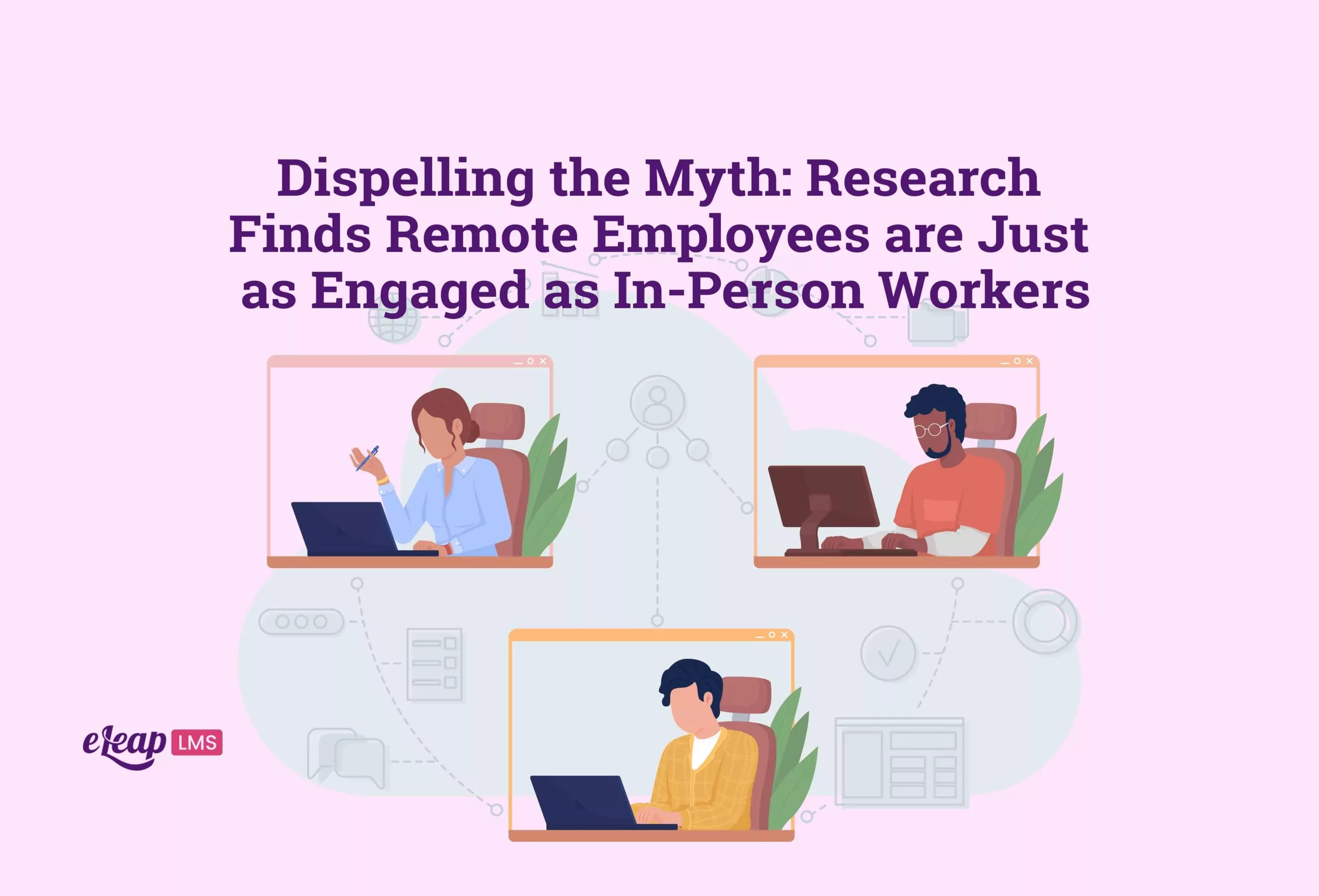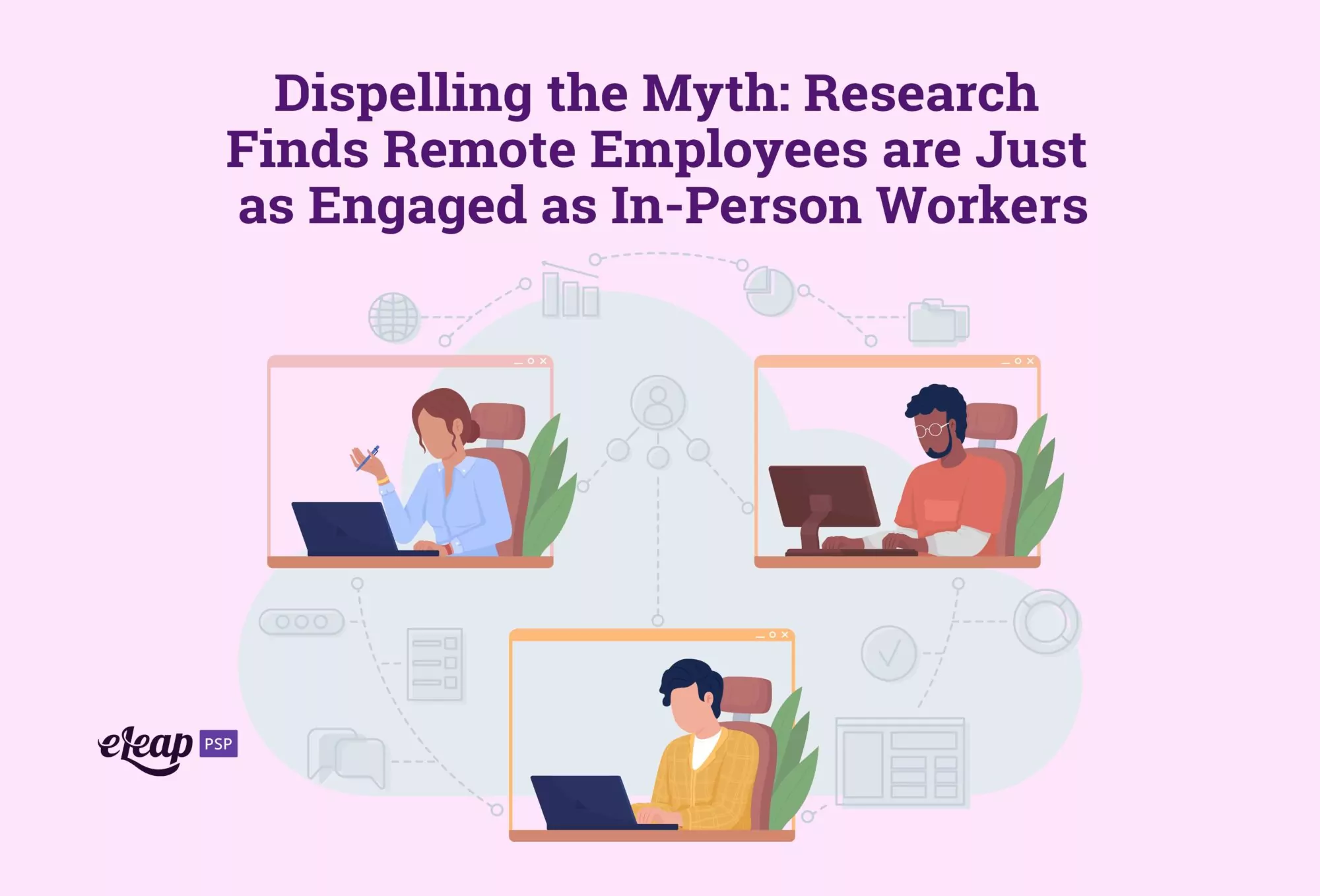Remote Employees are Just as Engaged as In-Person Workers, Despite Skepticism

Since the Covid-19 pandemic hit the world, remote working has gained immense popularity, especially in the corporate world. Many organizations have edged to working remotely to ensure their employees’ safety and keep their businesses running smoothly. Despite these, some employers worry that this modern way of working reduces employee engagement. However, recent research by Harvard Business Review proves otherwise. The study shows that remote workers exhibit increased engagement and thrive in their jobs. Explore how eLeaP®’s Performance Management Platform can simplify evaluations, boost productivity, and drive measurable results.

This article will shed light on the reasons behind this outcome. Here, you’ll also learn how organizations can improve employee engagement and how to transition from on-site working to remote working successfully. Let’s get into it!
Are Remote Workers Slacking?
Is it possible to nurture both flexibility and increased engagement within your organization? Are remote workers as engaged as on-site workers? These are some of the hard-hitting questions many employers and managers need answers to in order to make informed decisions about adopting remote work.
The short answer: Yes! Employees working remotely are as engaged as their counterparts working on-site. In fact, in some cases, they’re more engaged and tend to achieve more. Besides the HBR research proving that remote employees aren’t less involved, a two-year study by Stanford University shows that employees working remotely are:
- 50% less likely to quit.
- 9% more engaged in their jobs.
- 5% more productive than their office-based counterparts.
While this may seem counterintuitive, the stereotypical thought of a remote worker — someone sitting around in their pajamas and distracted by happenings in their surroundings — isn’t true in reality and must be shelved. Instead, think of remote workers as a diverse community of empowered, autonomous, entrepreneurial-minded professionals.
Reasons Why Remote Workers’ Engagement Level Increases
According to Harvard Business Review, the engagement levels of remote workers have increased in recent times due to the following factors:
Remote Meetings Occur More Frequently
The HBR research shows that in 2022, there were 60% more remote meetings per employee compared to 2020. Whether this is a bug or a feature of this new reality, having more frequent remote meetings has helped keep employees and team members engaged. One-on-ones and other meeting formats can easily adapt to the remote work environment. The more frequent meetings, the more remote workers engage with colleagues. This way, they can share ideas online, leading to increased productivity.
Remote Meetings Have Become Shorter
Imagine an individual going in for an online meeting that spans several hours and another for a session that lasts only about twenty to thirty minutes. There’s a high possibility that the latter will be more focused and engaged in the meeting than the former, who’ll probably get bored while the long meeting continues. Hence, managers opting for shorter-time meetings help to derive increased employee engagement.
Remote Meetings Became More Spontaneous
This factor influencing employee engagement can be linked to an employee not wanting to be caught “unprepared.” Knowing that their employers can initiate impromptu meetings is enough for them to engage with work fully. So, whenever meetings come up, they will be value-packed, and both employees and their employees can have meaningful discussions.
Guides To Improve Your Remote Workers’ Engagement
Below are tips to help improve your remote workers’ engagement levels:
Host Casual Hangouts And Virtual Meetings
It would help if you made time for casual video calls or work outings for your remote workers. For instance, a virtual get-together for non-official chat will do the magic. Please get to know your remote workers outside of their work lives. Knowing that you care for them and deliberately go out of your way to check on them beyond official motives is enough to boost their commitment to you and encourage a high engagement level.
Celebrate Employee Accomplishment
You should put extra effort into celebrating your remote workers’ contributions and efforts. You need to infuse an employee recognition program into your organization’s practices. This goes a long way to boost their engagement. Endeavor to always select your organization’s “employee of the month” and openly acknowledge and appreciate them during a web conferencing session. It’d help if you also celebrate special events, such as anniversaries and birthdays. According to Deloitte, employee recognition programs can boost remote workers’ productivity, engagement, and performance by 14%. At eLeaP, we also encourage you to help your employees and team members set clear goals and expectations so that effective feedback can be given and evident achievements can be determined.
Encourage Wellness And Health
Your employees’ health should be your priority. They shouldn’t perceive that you see them as tools utilized for work purposes alone but as assets that you cherish. You can even go the extra length by registering wellness programs for them, such as four weeks of daily walks or one month of yoga.
Aside from the support this brings to their health, it also gets your employees to form stronger bonds and prove that you care about their general well-being. Make healthy habits easier for them to practice. For instance, let them off early on sunny days to enjoy the sunshine or permit a more extended midday break for them to work out.
Make Your Employees Feel Valued And Heard
The easiest way to kill off employee engagement is to drown their efforts, ideas, and thoughts. Do not simply dismiss whatever suggestion they bring to the table, no matter how irrelevant you might assume it is – that’s like a quick way to shut them up forever. You should also be expressive about how you value their input into the organization. Send them virtual or physical gift cards on their birthdays and other special days. These and more will help them realize that you genuinely appreciate them, and as a result, they’ll value their tasks in return.
Tips for Organizations To Successfully Transition From On-site Working To Remote Working
Below are some tips that will help you successfully transition from on-site working to remote working:
- Establish clear communication channels: Make sure everyone knows how to communicate with each other and what tools to use. This could include email, messaging apps, video conferencing software, or project management tools.
- Set clear expectations: Establish guidelines and protocols for remote work, including work hours, communication standards, and deadlines. Encourage employees to be proactive in communicating their needs and challenges.
- Ensure access to necessary technology: Ensure your employees have the hardware and software to perform their jobs remotely. Support technical issues and ensure that all software and data are secure.
- Prioritize team building and social connection: Organize virtual team-building activities, encourage employees to socialize during work hours, and provide opportunities for non-work-related conversations to help maintain a sense of community and connection.
- Continuously evaluate and adjust: Regularly gather employee feedback and adapt your remote work policies and procedures accordingly. Encourage flexibility and open communication to ensure a successful transition to remote work.
- For additional tips, see this article.
In Conclusion
With the new findings by Harvard Business Review and Stanford University that there’s an increasing level of engagement among remote workers, organizations will begin to experience significant growth while spending less to achieve them.
Therefore, businesses must continue to support and embrace working remotely to enjoy the benefits it brings to every party involved. With the ideal support and tools, remote working can birth a new, more fulfilling work-life for everyone.